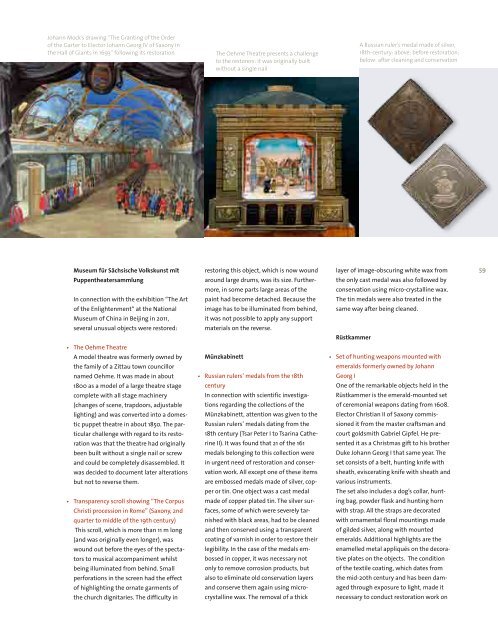Annual Report 2010 - Staatliche Kunstsammlungen Dresden
Annual Report 2010 - Staatliche Kunstsammlungen Dresden
Annual Report 2010 - Staatliche Kunstsammlungen Dresden
Create successful ePaper yourself
Turn your PDF publications into a flip-book with our unique Google optimized e-Paper software.
Johann Mock’s drawing “The Granting of the Order<br />
of the Garter to Elector Johann Georg iV of saxony in<br />
the Hall of Giants in 1693” following its restoration<br />
Museum für Sächsische Volkskunst mit<br />
puppentheatersammlung<br />
In connection with the exhibition “The Art<br />
of the Enlightenment“ at the National<br />
Museum of China in Beijing in 2011,<br />
several unusual objects were restored:<br />
• The Oehme Theatre<br />
A model theatre was formerly owned by<br />
the family of a Zittau town councillor<br />
named Oehme. It was made in about<br />
1800 as a model of a large theatre stage<br />
complete with all stage machinery<br />
(changes of scene, trapdoors, adjustable<br />
lighting) and was converted into a domestic<br />
puppet theatre in about 1850. The particular<br />
challenge with regard to its restoration<br />
was that the theatre had originally<br />
been built without a single nail or screw<br />
and could be completely disassembled. It<br />
was decided to document later alterations<br />
but not to reverse them.<br />
• Transparency scroll showing “The Corpus<br />
Christi procession in Rome” (Saxony, 2nd<br />
quarter to middle of the 19th century)<br />
This scroll, which is more than 11 m long<br />
(and was originally even longer), was<br />
wound out before the eyes of the spectators<br />
to musical accompaniment whilst<br />
being illuminated from behind. Small<br />
perforations in the screen had the effect<br />
of highlighting the ornate garments of<br />
the church dignitaries. The difficulty in<br />
The Oehme Theatre presents a challenge<br />
to the restorers: it was originally built<br />
without a single nail<br />
restoring this object, which is now wound<br />
around large drums, was its size. Furthermore,<br />
in some parts large areas of the<br />
paint had become detached. Because the<br />
image has to be illuminated from behind,<br />
it was not possible to apply any support<br />
materials on the reverse.<br />
Münzkabinett<br />
• Russian rulers’ medals from the 18th<br />
century<br />
In connection with scientific investigations<br />
regarding the collections of the<br />
Münzkabinett, attention was given to the<br />
Russian rulers’ medals dating from the<br />
18th century (Tsar Peter I to Tsarina Catherine<br />
II). It was found that 21 of the 161<br />
medals belonging to this collection were<br />
in urgent need of restoration and conservation<br />
work. All except one of these items<br />
are embossed medals made of silver, copper<br />
or tin. One object was a cast medal<br />
made of copper plated tin. The silver surfaces,<br />
some of which were severely tarnished<br />
with black areas, had to be cleaned<br />
and then conserved using a transparent<br />
coating of varnish in order to restore their<br />
legibility. In the case of the medals embossed<br />
in copper, it was necessary not<br />
only to remove corrosion products, but<br />
also to eliminate old conservation layers<br />
and conserve them again using microcrystalline<br />
wax. The removal of a thick<br />
a russian ruler’s medal made of silver,<br />
18th-century: above: before restoration;<br />
below: after cleaning and conservation<br />
layer of imageobscuring white wax from<br />
the only cast medal was also followed by<br />
conservation using microcrystalline wax.<br />
The tin medals were also treated in the<br />
same way after being cleaned.<br />
Rüstkammer<br />
• Set of hunting weapons mounted with<br />
emeralds formerly owned by Johann<br />
Georg I<br />
One of the remarkable objects held in the<br />
Rüstkammer is the emeraldmounted set<br />
of ceremonial weapons dating from 1608.<br />
Elector Christian II of Saxony commissioned<br />
it from the master craftsman and<br />
court goldsmith Gabriel Gipfel. He presented<br />
it as a Christmas gift to his brother<br />
Duke Johann Georg I that same year. The<br />
set consists of a belt, hunting knife with<br />
sheath, eviscerating knife with sheath and<br />
various instruments.<br />
The set also includes a dog’s collar, hunting<br />
bag, powder flask and hunting horn<br />
with strap. All the straps are decorated<br />
with ornamental floral mountings made<br />
of gilded silver, along with mounted<br />
emeralds. Additional highlights are the<br />
enamelled metal appliqués on the decorative<br />
plates on the objects. The condition<br />
of the textile coating, which dates from<br />
the mid20th century and has been damaged<br />
through exposure to light, made it<br />
necessary to conduct restoration work on<br />
59

















